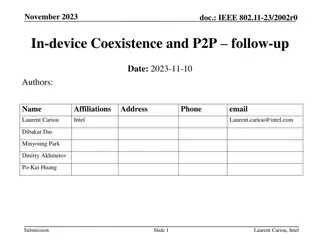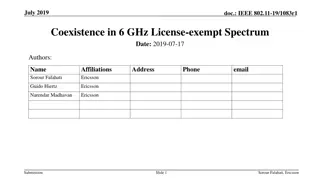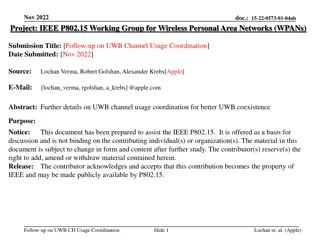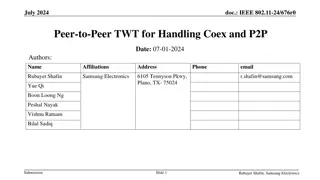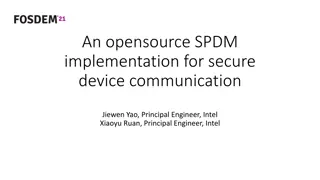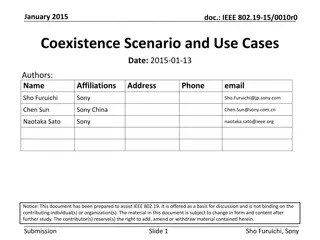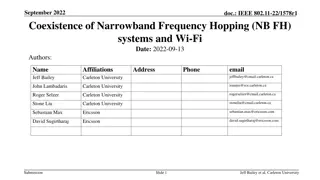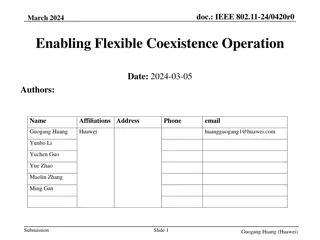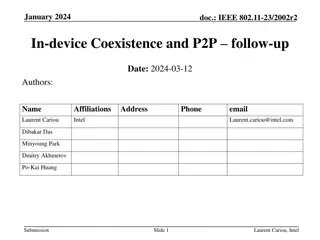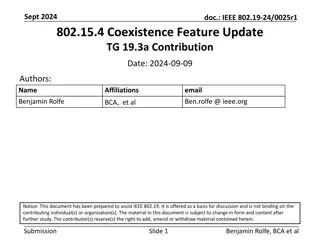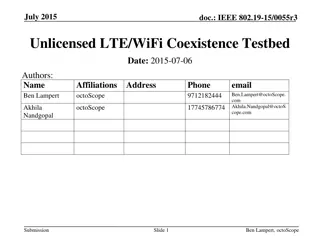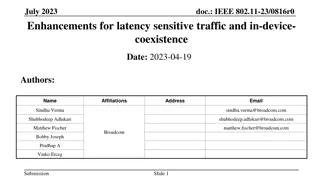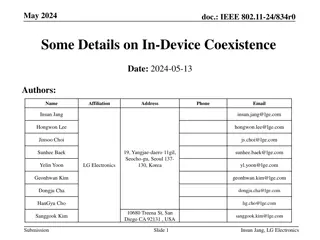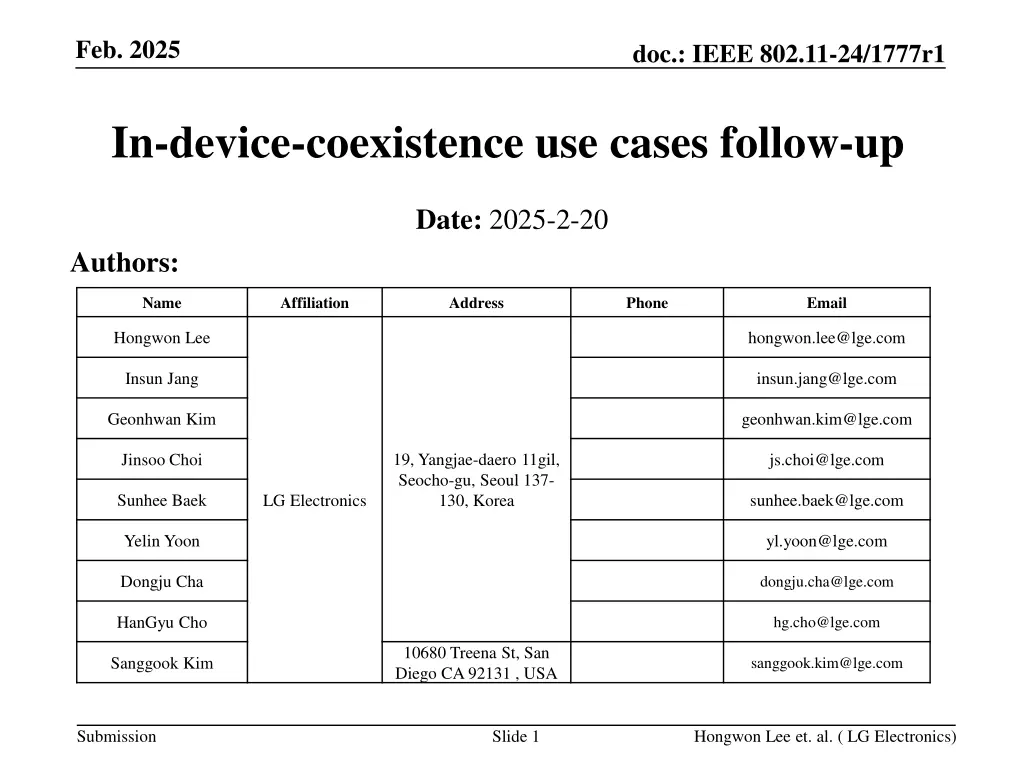
Understanding IEEE 802.11-24/1777r1 In-Device Coexistence Mechanisms
Explore the mechanisms for in-device coexistence in IEEE 802.11-24/1777r1, focusing on aspects like AP unavailability announcement, Scheduled AP Power Save mode, and more. Delve into use cases to identify potential issues when these mechanisms are in operation.
Download Presentation

Please find below an Image/Link to download the presentation.
The content on the website is provided AS IS for your information and personal use only. It may not be sold, licensed, or shared on other websites without obtaining consent from the author. If you encounter any issues during the download, it is possible that the publisher has removed the file from their server.
You are allowed to download the files provided on this website for personal or commercial use, subject to the condition that they are used lawfully. All files are the property of their respective owners.
The content on the website is provided AS IS for your information and personal use only. It may not be sold, licensed, or shared on other websites without obtaining consent from the author.
E N D
Presentation Transcript
Feb. 2025 doc.: IEEE 802.11-24/1777r1 In-device-coexistence use cases follow-up Date: 2025-2-20 Authors: Name Affiliation Address Phone Email Hongwon Lee hongwon.lee@lge.com Insun Jang insun.jang@lge.com Geonhwan Kim geonhwan.kim@lge.com 19, Yangjae-daero 11gil, Seocho-gu, Seoul 137- 130, Korea Jinsoo Choi js.choi@lge.com Sunhee Baek sunhee.baek@lge.com LG Electronics Yelin Yoon yl.yoon@lge.com Dongju Cha dongju.cha@lge.com HanGyu Cho hg.cho@lge.com 10680 Treena St, San Diego CA 92131 , USA Sanggook Kim sanggook.kim@lge.com Submission Slide 1 Hongwon Lee et. al. ( LG Electronics)
Feb. 2025 doc.: IEEE 802.11-24/1777r1 Introduction The Motion related to defining a mechanism for an AP to announce unavailability, which is related to periodic in-device- coexistence(IDC), was passed in the November F2F meeting The Motion related to reusing the mechanism for Scheduled AP Power Save mode was passed in the November F2F meeting The mechanism for AP Power Save mode can also be applied to AP Periodic Unavailability Operation due to in-device coexistence We should further examine use cases to determine if there are any issues when the mechanism operates in Scheduled AP Power Save Mode(PSM) and/or AP Periodic Unavailability Operation(PUO) We refer to AP Periodic Unavailability Operation as AP PUO for convenience in this contribution. This term can be further discussed within this group to determine a more appropriate one if necessary Submission Slide 2 Hongwon Lee et. al. ( LG Electronics)
Feb. 2025 doc.: IEEE 802.11-24/1777r1 Scheduled AP PSM mechanism The current rules for TWT scheduling APs, aligned with Motion 161, are defined in subclause 26.8.3.2 (Rules for TWT Scheduling APs), and the unavailability outside of broadcast TWT SPs can currently be applied optionally 26.8.3.2 Rules for TWT scheduling AP (#4010)If a TWT scheduling AP has advertised a TWT element that carries one or more Broadcast TWT Parameter Set fields with a Broadcast TWT ID subfield equal to 0 and a Responder PM Mode subfield equal to 1, then: If the NDP Paging Indicator/Unavailability Mode subfield is set to 0, the AP may be unavailable outside of these broadcast TWT SPs, except within any other TWT SP that is setup with the AP or advertised by the AP. If the NDP Paging Indicator/Unavailability Mode subfield is set to 1, the AP may be unavailable outside of these broadcast TWT SPs, even if that time falls within any other TWT SP that is setup with the AP or advertised by the AP. . The TWT scheduling AP shall include a unique value in the Broadcast TWT ID subfield for each Broadcast TWT to allow identification of each Broadcast TWT, unless the TWT Setup Command field is Alternate TWT or the Broadcast TWT ID subfield is zero. NOTE 6 The broadcast TWT element contains two Broadcast TWT Parameter Set fields with the same Broadcast TWT ID subfield value if the TWT Setup Command field indicates Alternate TWT in one of the Broadcast TWT Parameter Set fields. The broadcast TWT element might contain multiple Broadcast TWT Parameter Set fields with the Broadcast TWT ID subfield equal to 0. In order to apply this mechanism for Scheduled AP PSM and AP PUO, we need so slightly change these rules Submission Slide 3 Hongwon Lee et. al. ( LG Electronics)
Feb. 2025 doc.: IEEE 802.11-24/1777r1 Considerations for Scheduled AP PSM and AP PUO The rules discussed in the previous slide are optional in the baseline For UHR STAs, these rules shall apply in cases where an AP operates in Scheduled AP PSM and/or AP PUO Additionally, if an UHR AP operates with multiple Broadcast TWT for Scheduled AP PSM and/or AP PUO, the overlapped periods outside the broadcast TWT SPs should not be unavailable anymore To guarantee unavailable in the overlapped periods, the NDP Paging Indicator/Unavailability Mode subfield shall be set to 1(stating may in the baseline) Submission Slide 4 Hongwon Lee et. al. ( LG Electronics)
Feb. 2025 doc.: IEEE 802.11-24/1777r1 Consideration for the unavailability mode subfield Case 1: The outside of Broadcast TWT SPs that do not overlap(either fully or partially) with any other TWT SP by the AP Unavailability mode set to either 0 or 1 are allowable Case 2: The outside of Broadcast TWT SPs that overlap(either fully or partially) with any other TWT SP by the AP Only unavailability mode set to 1 is allowable The simple proposal to add rules for TWT Scheduling APs If a TWT scheduling UHR AP has advertised a TWT element that carries one or more Broadcast TWT Parameter Set fields with a Broadcast TWT ID subfield equal to 0 and a Responder PM Mode subfield equal to 1, for Scheduled AP PSM and/or AP PUO, then: The value of the NDP Paging Indicator/Unavailability Mode subfield, either 0 or 1, is permissible if the time outside of these Broadcast TWT SPs does not fall within any other TWT SP that is setup with the UHR AP or advertised by the UHR AP. The value of the NDP Paging Indicator/Unavailability Mode subfield shall be set to 1 if the time outside these Broadcast TWT SPs falls within any other TWT SP that is setup with the UHR AP or advertised by the UHR AP. In this case, the UHR AP shall be considered unavailable outside these Broadcast TWT SPs Submission Slide 5 Hongwon Lee et. al. ( LG Electronics)
Feb. 2025 doc.: IEEE 802.11-24/1777r1 Conclusion We discussed reusing the baseline mechanism for TWT scheduling APs to apply to Scheduled AP PSM and AP PUO For efficient power consumption, avoidance of unnecessary medium access and unfavorable rate adaptation, the doze state during the overlapping periods shall be guaranteed A simple rule can be added to achieve this The value of the NDP Paging Indicator/Unavailability Mode subfield shall be set to 1 if the time outside these Broadcast TWT SPs falls within any other TWT SP that is setup with the UHR AP or advertised by the UHR AP. In this case, the UHR AP shall be considered unavailable outside these Broadcast TWT SPs Through this, the efficient operation of Scheduled AP PSM and/or AP PUO can be achieved Submission Slide 6 Hongwon Lee et. al. ( LG Electronics)
Feb. 2025 doc.: IEEE 802.11-24/1777r1 Straw Poll 1 Do you agree to include the following into the 11bn SFD? The report for long term(periodic) unavailability due to in-device- coexistence on AP side is performed in UHR using Broadcast TWT with TWT ID=0 with Responder PM=1 as described in 26.8.3.2 (Rules for TWT scheduling AP) Submission Slide 7 Hongwon Lee et. al. ( LG Electronics)
Feb. 2025 doc.: IEEE 802.11-24/1777r1 Straw Poll 2 Do you agree to include the following into the 11bn SFD? If a TWT scheduling UHR AP has advertised a TWT element that carries one or more Broadcast TWT Parameter Set fields with a Broadcast TWT ID subfield equal to 0 and a Responder PM Mode subfield equal to 1, for Scheduled AP PSM and/or AP PUO, then: The value of the NDP Paging Indicator/Unavailability Mode subfield, either 0 or 1, is permissible if the time outside of these Broadcast TWT SPs does not fall within any other TWT SP that is setup with the UHR AP or advertised by the UHR AP. The value of the NDP Paging Indicator/Unavailability Mode subfield shall be set to 1 if the time outside these Broadcast TWT SPs falls within any other TWT SP that is setup with the UHR AP or advertised by the UHR AP. In this case, the UHR AP shall be considered unavailable outside these Broadcast TWT SPs Submission Slide 8 Hongwon Lee et. al. ( LG Electronics)
Feb. 2025 doc.: IEEE 802.11-24/1777r1 References [1] 11-24/831r0, Periodic IDC use cases and considerations for signaling [2] 11-24/1108r1, Periodic IDC signaling for UHR Mobile AP [3] 11-24/1490r0, More Consideration of ICR/CRF for in-device-coexistence [4] 11-23/1103r0, In-Device Interference Discussion [5] 11-23/1934r0, In-Device Interference Mitigation Follow Up [6] 11-23/2002r2, In-device coexistence and interference follow-up Submission Slide 9 Hongwon Lee et. al. ( LG Electronics)


